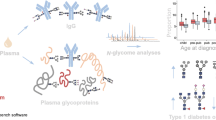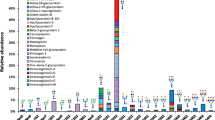Abstract
Various α1-acid glycoprotein (AGP) glycoforms are present in plasma differing in extent of branching and/or fucosylation of their 5 N-linked glycans, as well as in concentration. It is assumed that hepatic synthesis determines the relative occurrence of the AGP-glycoforms in plasma, but experimental evidence is lacking. In this study, we have investigated the contribution of fractional synthesis rates to the plasma concentration of AGP-glycoforms that differed in relative occurrence in healthy human plasma. During a [13C]valine infusion, AGP was isolated from the plasma of healthy volunteers. Four AGP-glycoforms, differing strongly in plasma concentration were obtained by sequential affinity chromatography over concanavalin-A- and Aleuria aurantia-agarose columns. The incorporation of the [13C]valine tracer into the AGP-glycoforms was measured by gas chromatography combustion isotope ratio mass spectrometry. The mean fractional synthesis rates of the four AGP-glycoforms did not differ significantly between each other as well between individuals. The results indicated a renewal of about 15%/day of the plasma pools of each of the AGP-glycoforms. This is in support to the assumption that the differences in plasma concentration of the AGP-glycoforms are a reflection of the state of the hepatic glycosylation process. Published in 2004.
Similar content being viewed by others
References
Hochepied T, Berger FG, Baumann H, Libert C, ? 1-Acid glycoprotein: an acute phase protein with inflammatory and immunomodulating properties, Cytokine Growth Factor Rev 14, 25-34 (2003).
Kushner I, The phenomenon of the acute-phase response, Ann NY Acad Sci 389, 39-48 (1982).
Schmid K, Nimberg RB, Kimura A, Yamaguchi H, Binette JP, The carbohydrate units of alpha1-acid glycoprotein, Biochim Biophys Acta 492, 291-302 (1977).
Treuheit MJ, Costello CE, Halsall HB, Analysis of the five glycosylation sites of human AGP, Biochem J 283, 105-12 (1992).
Wieruszeski JM, Fournet B, Konan D, Durand G, 400-MHz 1H-NMR spectroscopy of fucosylated tetrasialyloligosaccharides from normal and cirrhotic AGP, FEBS Lett 238, 390-4 (1988).
Brinkman-Van der Linden ECM, Mollicones R, Oriol R, Larson G, Van den Eijnden DH, Van Dijk W, A Missence mutation in the FUT6 gene results in total absence of ?3-fucosylation of human alpha1-acid glycoprotein, J Biol Chem 271, 14492-5 (1996).
De Graaf T, Van der Stelt ME, Anbergen GM, Van Dijk W, Inflammation-induced expression of sialyl Lewis-x-containing glycan structures on ? 1-acid glycoprotein (orosomucoid) in human sera, J Exp Med 177, 657-66 (1993).
Van Dijk W, Brinkman-Van der Linden ECM, Havenaar EC, Glycosylation of ?1-acid glycoprotein (orosomucoid) in health and disease: occurrence, regulation and possible functional implications, Trends Glycosci Glycotechnol 53, 235-45 (1998).
Van Dijk W, ?1-Acid glycoprotein: a natural occurring antiinflammatory molecule? Adv Exp Med Biol 376, 223-9 (1995).
Brinkman-Van der Linden ECM, Van Ommen ECR, Van Dijk W, Glycosylation of ?1-acid glycoprotein in septic shock: changes in degree of branching and in expression of sialyl Lewis-x groups, Glycoconjugate J 13, 27-31 (1996).
Havenaar EC, Dolhain RJEM, Turner GA, Goodarzi MT, Van Ommen EC, Breedveld FC, Van Dijk W, Do synovial fluid acute phase proteins from patients with rheumatoid arthritis originate from serum, Glycoconjugate J 14, 457-65 (1997).
Pos O, Van der Stelt ME, Wolbink GJ, Nijsten MWN, Van der Tempel GL, Van Dijk W, Changes in the serum concentration and glycosylation of ?1-acid glycoprotein and alpha1-protease inhibitor in severely burned patients: relation to interleukin-6 levels, Clin Exp Immunol 82, 579-82 (1990).
Hervé F, Duche JC, Dathis P, Marche C, Barre J, Tillement JP, Binding of diisopyramide, methadone, dipyridamole, chlorpromazine, lidocaine and progesterone to the two main genetic variants of human alpha1-acid glycoprotein. Evidence for drugbinding difference between the variants and for the presence of two separate drug-binding sites on the ?1-acid glycoprotein, Pharmacogenetics 6, 403-15 (1996).
Pervaiz S, Brew K, Homology and structure-function correlations between ? 1-acid glycoprotein and serum retinol-binding protein and its relatives, FASEB J 1, 209-14 (1987).
Costello M, Fiedel BA, Gewurz H, Inhibition of platelet aggregation by native and desialylated alpha1-acid glycoprotein, Nature 281,677-8 (1979).
Pos O, Moshage HJ, Yap SH, Snieders JPMALA, Van Gool J, Boers W, Brugman AM, Van Dijk W, Effects of monocytic products, recombinant interleukin-1 and recombinant interleukin-6 on the glycosylation of ? 1-acid glycoprotein: studies with primary human hepatocyte cultures and rats, Inflammation 13, 415-24 (1989).
Williams JP, Weisser MR, Pechet TTV, Kobzik L, Moore FD, Hechtman HB, ? 1-Acid glycoprotein reduces local and remote injuries after intestinal ischemia in the rat,AmJ Physiol 273, G1031-5 (1997).
Pos O, Oostendorp RAJ, Van der Stelt ME, Scheper RJ, Van Dijk W, Con A-non reactive human ? 1-acid glycoprotein (AGP) is more effective in modulation of lymphocyte proliferation than Con Areactive AGP serum variants, Inflammation 14, 133-41 (1990).
Havenaar EC, Hoff RC, Van den Eijnden DH, Van Dijk W, Sialyl Lewis X epitopes do not occur on acute phase proteins in mice: relationship to the absence of ?3-fucosyltransferase in the liver, Glycoconjugate J 15, 389-95 (1998).
McGuire EAM, Helderman JH, Tobin JD, Andres R, Berman M, Effects of arterial versus venous sampling on analysis of glucose kinetics in man, J Appl Physiol 41, 565-7 (1976).
Mancini G, Carbonara AO, Heremans JF, A single radial diffusion method for the immunological quantification of proteins, Immunochemistry 2, 235-54 (1965).
Kulik W, Jacobs C, De Meer K, Determination of extracellular and intracellular enrichments of ?-[1-13C]ketoisovalerate using enzymatically converted [1-13C]valine standardization curves and gas chromatography-mass spectrometry, J Chromatogr B 729, 211-6 (1999).
Kulik W, Meesterburrie JAN, Jakobs C, De Meer K, Determination of delta-13C values of valine in protein hydrolysate by gas chromatography-combustion isotope ratio mass spectrometry, J Chromatogr B 710, 37-47 (1998).
Schachter H, The joys of HexNAc. The synthesis and function of N-and O-glycan branches, Glycoconjugate J 17, 465-83 (2000).
Van Dijk W, Pos O, Van der Stelt ME, Moshage HJ, Yap SH, Dente L, Baumann P, Eap CB, Inflammation-induced changes in expression and glycosylation of genetic variants of ?1-acid glycoprotein (AGP): studies with human sera, primary cultures of human hepatocytes and transgenic mice, Biochem J 276, 343-7 (1991).
Baumann H, Gauldie J, The acute phase response, Immunol Today 15, 74-80 (1994).
Dalziel M, Lemaire S, Ewing J, Kobayashi L, Lau JT, Hepatic acute phase induction of murine ?-galactoside ?2,6-sialyltransferase (ST6Gal I) is IL-6 dependent and mediated by elevation of exon H-containing class of transcripts, Glycobiology 9, 1003-8 (1999).
Jamieson JC, McCaffrey G, Harder PG, Sialyltransferase: a novel acute-phase reactant, Comp Biochem Physiol B 105, 29-33 (1993).
Lombart C, Sturgess J, Schachter H, The effect of turpentineinduced inflammation on rat liver glycosyltransferases and Golgi complex ultrastructure, Biochim Biophys Acta 629, 1-12 (1980).
Memon RA, Holleran WM, Uchida Y, Moser AH, Ichikawa S, Hirabayashi Y, Grunfeld C, Feingold KR, Regulation of glycosphingolipid metabolism in liver during the acute phase response, J Biol Chem 274, 19707-13 (1999).
Tanaka S, Yazawa S, Noguchi K, Nishimura T, Miyanaga K, Kochibe N, Poland DCW, Van Dijk W, Matta KL, Molecular analysis of plasma ?1, 3-fucosyltransferase deficiency and development of the methods of genotyping, Exptl Clin Immunogen 18, 1-12 (2001).
Van Dijk W, Boers W, Sala M, Lasthuis AM, Mookerjea S, Activity and secretion of sialyltransferase in primary monolayer cultures of rat hepatocytes cultured with and without dexamethasone, Biochem Cell Biol 64, 79-84 (1986).
Jahoor F, Gazzard B, Philips G, Sharpstone D, Delrosario M, Frazer ME, Heard W, Smith R, Jackson A, The acute phase response to human immunodeficiency virus infection in human subjects, Am J Physiol 276, E1092-8 (1999).
Mansoor O, Cayol M, Gachon P, Boirie Y, Schoeffler P, Obled C, Beaufrere B, Albumin and fibrinogen synthesis increase while muscle protein synthesis decreases in head-injured patients, Am J Physiol 273, E898-E902 (1997).
Preston T, Slater C, McMillan DC, Falconer JS, Shenkin A, Fearon KC, Fibrinogen synthesis is elevated in fasting cancer patients with an acute phase response, J Nutr 128, 1355-60 (1998).
De Sain-van der Velden MGM, Kaysen GA, De Meer K, Stellaard F, Voorbij AM, Reijngoud DJ, Rabelink TJ, Koomans HA, Proportionate increase of fibrinogen and albumin synthesis in nephrotic patients: measurements with stable isotopes,Kidney Int 53, 181-8 (1998).
Foster DM, Barrett PH, Toffolo G, Beltz WF, Cobelli C, Estimating the fractional synthetic rate of plasma apolipoproteins and lipids from stable isotope data, J Lipid Res 34, 2193-205 (1993).
Woloski BM, Gospodarek E, Jamieson JC, Studies of monokines as mediators of the acute phase response: effects on sialyltransferase, albumin, ?1-acid glycoprotein and ?-Nacetylhexosaminidase, Biochem Biophys Res Commun 130, 30-6 (1985).
Author information
Authors and Affiliations
Corresponding author
Rights and permissions
About this article
Cite this article
Poland, D.C., Kulik, W., van Dijk, W. et al. Distinct glycoforms of human α1-acid glycoprotein have comparable synthesis rates: a [13C]valine-labelling study in healthy humans. Glycoconj J 20, 99–105 (2003). https://doi.org/10.1023/B:GLYC.0000018584.66712.2c
Issue Date:
DOI: https://doi.org/10.1023/B:GLYC.0000018584.66712.2c




